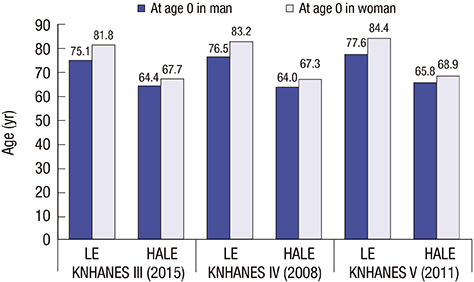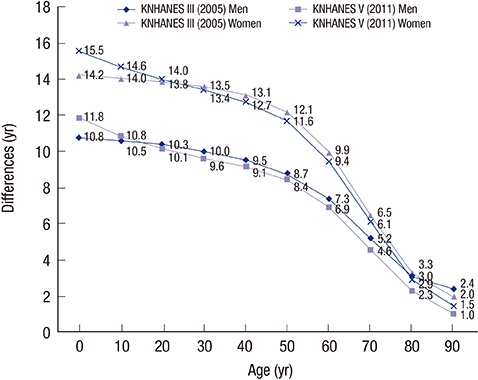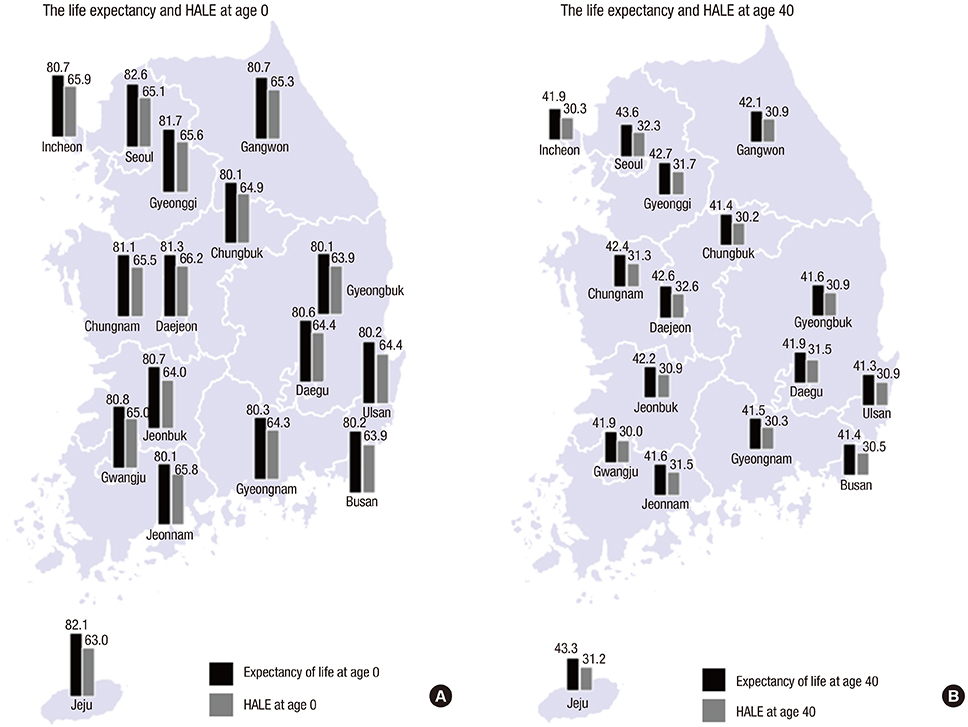Health-Adjusted Life Expectancy (HALE) in Korea: 2005–2011
- Affiliations
-
- 1Public Health Medical Service, Boramae Medical Center, Seoul National University College of Medicine, Seoul, Korea.
- 2Institute of Health Policy and Management, Medical Research Center, Seoul National University, Seoul, Korea.
- 3Department of Preventive Medicine, University of Ulsan College of Medicine, Seoul, Korea. mdjominwoo@gmail.com
- 4Department of Medicine, University of Ulsan College of Medicine, Seoul, Korea.
- 5Department of Nursing Science, Shinsung University, Dangjin, Korea.
- KMID: 2360664
- DOI: http://doi.org/10.3346/jkms.2016.31.S2.S139
Abstract
- Health-Adjusted Life Expectancy (HALE) is a summary measurement that estimates the average number of years that a person at a given age can expect to live an equivalent of full health. HALE has not been previously reported at national or regional levels in Korea. This study aimed to measure HALE from 2005 to 2011 in Korea at both the national and regional levels as part of the Korean National Burden Study of 2012. To measure life expectancy (LE) and HALE, we used the life table method and an approach proposed by Sullivan. We used three main data sets to estimate HALE: probability of death, prevalence of disease, and disability weights. Overall, LE and HALE have increased from 2005 to 2011. For example, in 2011, LE and HALE at birth in males were 77.6 and 65.8 years, respectively, and 84.4 and 68.9 in females. It might be assumed that the overall health status of Korean population has been increasing. However, we confirmed that a gap between LE and HALE still exists. Additionally, we found out that there was a significant difference between LE and HALE among various sub-regions. This study is the first to measure HALE using our own database, including disability weight that reflected Korean preferences. Finally, the Korean government and society should make an effort to reduce the gap between LE and HALE and to reduce regional differences.
Keyword
MeSH Terms
Figure
Cited by 4 articles
-
The Korean National Burden of Disease Study: from Evidence to Policy
Seok-Jun Yoon, Dun-Sol Go, Hyesook Park, Min-Woo Jo, In-Hwan Oh, Young-Eun Kim
J Korean Med Sci. 2019;34(Suppl 1):. doi: 10.3346/jkms.2019.34.e89.The Trends in Health Life Expectancy in Korea according to Age, Gender, Education Level, and Subregion: Using Quality-Adjusted Life Expectancy Method
Min-Woo Jo, Wanu Seo, So Yun Lim, Minsu Ock
J Korean Med Sci. 2019;34(Suppl 1):. doi: 10.3346/jkms.2019.34.e88.Disability Weights Measurement for 289 Causes of Disease Considering Disease Severity in Korea
Minsu Ock, Bomi Park, Hyesook Park, In-Hwan Oh, Seok-Jun Yoon, Bogeum Cho, Min-Woo Jo
J Korean Med Sci. 2019;34(Suppl 1):. doi: 10.3346/jkms.2019.34.e60.Cancer-free Life Expectancy in Small Administrative Areas in Korea and Its Associations with Regional Health Insurance Premiums
Eunjeong Noh, Hee-Yeon Kang, Jinwook Bahk, Ikhan Kim, Young-Ho Khang
J Korean Med Sci. 2021;36(42):e269. doi: 10.3346/jkms.2021.36.e269.
Reference
-
1. U.S. National Library of Medicine. MeSH subject headings [Internet]. accessed on 10 November 2015. Available at http://www.ncbi.nlm.nih.gov/mesh/?term=life+expectancy.2. Field MJ, Gold MR. Summarizing Population Health: Directions for the Development and Application of Population Metrics. Washington, D.C.: National Academy Press;1998.3. Murray CJ, Salomon JA, Mathers CD, Lopez AD. Summary Measures of Population Health: Concepts, Ethics, Measurement and Applications. Geneva: World Health Organization;2002.4. Sullivan DF. A single index of mortality and morbidity. HSMHA Health Rep. 1971; 86:347–354.5. Salomon JA, Wang H, Freeman MK, Vos T, Flaxman AD, Lopez AD, Murray CJ. Healthy life expectancy for 187 countries, 1990-2010: a systematic analysis for the global burden disease study 2010. Lancet. 2012; 380:2144–2162.6. Gold MR, Stevenson D, Fryback DG. HALYS and QALYS and DALYS, Oh My: similarities and differences in summary measures of population health. Annu Rev Public Health. 2002; 23:115–134.7. Hyder AA, Puvanachandra P, Morrow RH. Measuring the health of populations: explaining composite indicators. J Public Health Res. 2012; 1:222–228.8. Mathers CD, Vos T, Lopez AD, Salomon J, Ezzati M. National Burden of Disease Studies: a Practical Guide (Edition 2.0. Global Program on Evidence for Health Policy). Geneva: World Health Organization;2001.9. Crimmins EM, Saito Y. Trends in healthy life expectancy in the United States, 1970-1990: gender, racial, and educational differences. Soc Sci Med. 2001; 52:1629–1641.10. Brønnum-Hansen H. Health expectancy in Denmark, 1987-2000. Eur J Public Health. 2005; 15:20–25.11. Nepomuceno MR, Turra CM. Trends in healthy life expectancy among older Brazilian women between 1998 and 2008. Rev Saude Publica. 2015; 49:1–8.12. Banham D, Woollacott T, Lynch J. Healthy life gains in South Australia 1999-2008: analysis of a local burden of disease series. Popul Health Metr. 2011; 9:13.13. Doblhammer G, Kytir J. Compression or expansion of morbidity? Trends in healthy-life expectancy in the elderly Austrian population between 1978 and 1998. Soc Sci Med. 2001; 52:385–391.14. Lau RS, Johnson S, Kamalanabhan TJ. Healthy life expectancy in the context of population health and ageing in India. Asia Pac J Public Health. 2012; 24:195–207.15. Gu D, Dupre ME, Warner DF, Zeng Y. Changing health status and health expectancies among older adults in China: gender differences from 1992 to 2002. Soc Sci Med. 2009; 68:2170–2179.16. Chiang CL. The Life Table and Its Applications. Malabar, FL: Robert E. Krieger Publishers;1984.17. Kweon S, Kim Y, Jang MJ, Kim Y, Kim K, Choi S, Chun C, Khang YH, Oh K. Data resource profile: the Korea National Health and Nutrition Examination Survey (KNHANES). Int J Epidemiol. 2014; 43:69–77.18. Ock M, Lee JY, Oh IH, Park H, Yoon SJ, Jo MW. Disability Weights Measurement for 228 Causes of Disease in the Korean Burden of Disease Study 2012. J Korean Med Sci. 2016; 31:Suppl 2. S129–S138.19. Vos T, Flaxman AD, Naghavi M, Lozano R, Michaud C, Ezzati M, Shibuya K, Salomon JA, Abdalla S, Aboyans V, et al. Years lived with disability (YLDs) for 1160 sequelae of 289 diseases and injuries 1990-2010: a systematic analysis for the global burden of disease study 2010. Lancet. 2012; 380:2163–2196.20. Stiefel MC, Perla RJ, Zell BL. A healthy bottom line: healthy life expectancy as an outcome measure for health improvement efforts. Milbank Q. 2010; 88:30–53.21. Fouweather T, Gillies C, Wohland P, Van Oyen H, Nusselder W, Robine JM, Cambois E, Jagger C. JA: EHLEIS Team. Comparison of socio-economic indicators explaining inequalities in healthy life years at age 50 in Europe: 2005 and 2010. Eur J Public Health. 2015; 25:978–983.22. Lagiewka K. European innovation partnership on active and healthy ageing: triggers of setting the headline target of 2 additional healthy life years at birth at EU average by 2020. Arch Public Health. 2012; 70:23.23. Jagger C. Trends in life expectancy and healthy life expectancy [Internet]. accessed on 8 March 2016. Available at https://www.gov.uk/government/uploads/system/uploads/attachment_data/file/464275/gs-15-13-future-ageing-trends-life-expectancy-er12.pdf.24. Steensma C, Loukine L, Orpana H, Lo E, Choi B, Waters C, Martel S. Comparing life expectancy and health-adjusted life expectancy by body mass index category in adult Canadians: a descriptive study. Popul Health Metr. 2013; 11:21.25. Bebbington A, Bajekal M. Sub-national variations in health expectancy. In : Robine JM, Jagger C, Mathers CD, Crimmins EM, Suzman RM, editors. Determining Health Expectancies. Chichester: Wiley;2003. p. 127–147.26. Manuel DG, Goel V, Williams JI, Corey P. Health-adjusted life expectancy at the local level in Ontario. Chronic Dis Can. 2000; 21:73–80.27. Smith M, Edgar G, Groom G; Office for National Statistics. Health expectancies in the United Kingdom, 2004-06. Health Stat Q. 2008; 40:77–80.28. Ock M, Han JW, Lee JY, Kim SH, Jo MW. Estimating quality-adjusted life-year loss due to noncommunicable diseases in Korean adults through to the year 2040. Value Health. 2015; 18:61–66.29. Lee J, Lee WY, Noh M, Khang YH. Does a geographical context of deprivation affect differences in injury mortality? A multilevel analysis in South Korean adults residing in metropolitan cities. J Epidemiol Community Health. 2014; 68:457–465.
- Full Text Links
- Actions
-
Cited
- CITED
-
- Close
- Share
- Similar articles
-
- Trends in Healthy Life Expectancy (HALE) and Disparities by Income and Region in Korea (2008–2020): Analysis of a Nationwide Claims Database
- Health-adjusted life expectancy according to lifestyle classified by the Yonsei Lifestyle Profile-BREF
- Review of Issues for Disability Weight Studies
- The Trends in Health Life Expectancy in Korea according to Age, Gender, Education Level, and Subregion: Using Quality-Adjusted Life Expectancy Method
- A Review of the Types and Characteristics of Healthy Life Expectancy and Methodological Issues




